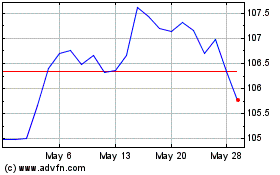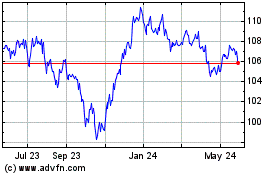Treasury bond yields are now near their all-time lows as the
fears over global economic slowdown continue to push
the investors towards “safe haven assets”.
The benchmark 10-year note yield is now touching 1.61% and thus
investment in these bonds is almost guaranteed to result in loss of
principal in real terms since the inflation rate is close to 2%.
(Read: Top Two Emerging Market USD Bond ETFs Head-to-Head)
In its efforts to stimulate the economy, the Fed has kept the
short-term interest rates near zero since late 2008 and it expects
the rates to stay at these levels at least through late
2014.
Additionally, it has bought more than $2 trillion in bonds to
keep the long term interest rates low. After its FOMC meeting last
week, the central bank decided to extend the Operation Twist
through the end of the year.
The Fed also downgraded its outlook for the GDP growth and
reiterated that it stands ready to take more action (including
additional bond purchases) if the labor market weakens further.
(Read: Follow Buffett With These Developed Market Bond
ETFs)
During the press conference after the meeting, the Fed chairman
Bernanke stated that by buying Treasuries, the Fed is actually
encouraging the investors to buy other assets like corporate
bonds.
While the short-term rates are already at near zero levels, the
longer-term rates and corporate bond yields could go lower in the
coming months due to Fed action.
According to some studies, the long-term rates fall 0.03% or a
bit more for every $100 billion of long-term bonds that the central
bank purchases.
As the Euro-zone continues to be a mess, recovery in the U.S.
seems to be stalling and emerging economies are going through
worse-than-expected slowdown, the rates do not seem to be going up
anytime soon though they will have to go up
eventually. Also, inflation does not seem to be a
concern as of now.
Further, If the European situation does not improve
substantially, there is a good chance that government bonds and
high quality corporate bonds may outperform the stocks over the
next six months to one year period. (Read: Play Europe with This
ETF Pair Trade)
What does this mean for the fixed income portfolios of investors
and how can the investors take advantage of decline in rates with
an investment horizon of about one year in mind?
With the Treasury bonds yielding paltry returns (in nominal
terms), the retail investors should instead consider buying high
quality corporate bonds, which provide significant yield pick-up
with only a slight increase in risk.
Due to solid balance sheets and high cash levels of the
investment grade US corporates, the chances of default are
very-very low. Thus the investment-grade corporate bonds can be
considered near-safe as far as credit risk is considered.
Further if the global economic situation worsens leading to
further “flight to quality”, the high yield bonds will suffer much
more than the investment grade bonds.
ETFs are the most convenient and inexpensive way to gaining
exposure to Investment grade corporate credit and the investors
have a choice of many ETFs available to them. The investors should
however remember that unlike individual bonds which return
principal on the maturity date, most bond ETFs do not have a
maturity date and principal value will continue to fluctuate during
the period of holding.
iShares iBoxx $ Investment Grade Corporate Bond Fund
(LQD)
Launched in July 2002, the fund has attracted more than $22
billion in assets so far and is the largest and most liquid ETF
within this space. The ETF currently holds 957 securities and
charges a low 15 basis annually to the investors for its expenses.
Financials (36.4%), Consumer Services (12.3%) and Oil & Gas
(10.6%) occupy the top spots in terms of sector breakdown. Average
maturity of the holdings is 11.9 years, while the effective
duration is 7.49 years.
12 month distribution yield is 4.14% currently. The fund has
gone up 3.07% year-to-date, after an impressive 8.89% rise in
2011.
PIMCO Investment Grade Corporate Bond Index Fund
(CORP)
CORP seeks to match the total return of BofA Merrill Lynch US
corporate Index, which is comprised of U.S. dollar
denominated investment grade, fixed rate corporate debt. Top five
industries are Banks (15%), Electric Utility (7%), Brokerage (7%),
Pharmaceuticals (5%) and Integrated oil (5%). Launched in
September 2010, the fund currently has $256.9 million in AUM, which
it holds in 190 holdings.
Average effective maturity of the fund is 9.4 years and the
effective duration is 6.3 years. 12 month distribution yield is
3.21% currently. The ETF charges 0.20% in expenses and has returned
4.95% year-to-date and 9.07% over one-year period. The fund has
assigned 72% weight to US, 6.5% to UK and 3.4% to Canada.
iShares Barclays Credit Bond (CFT)
CFT seeks to track investment grade credit sector of the
bond market, as defined by Barclays US Credit Bond Index. The fund
has 1880 holdings with a weighted average maturity of 9.91 years
and an effective duration of 6.41 years. ETF has assigned heaviest
weight to Industrial sector (43%), followed by Financials (23%) and
Utilities (9%).
Launched in January 2007, the fund has attracted $1.29 billion
in AUM so far. The expense ratio is 20 basis points per year and
the 12 month yield is 3.87% currently. The fund has returned 1.89%
year-to-date, after 8.05% return in 2011.
Want the latest recommendations from Zacks Investment Research?
Today, you can download 7 Best Stocks for the Next 30
Days. Click to get this free report
ISHARS-BR CB FD (CFT): ETF Research Reports
PIMCO-IG CBIF (CORP): ETF Research Reports
ISHARES GS CPBD (LQD): ETF Research Reports
To read this article on Zacks.com click here.
Zacks Investment Research
iShares iBoxx Dollar Inv... (AMEX:LQD)
Historical Stock Chart
From Apr 2024 to May 2024

iShares iBoxx Dollar Inv... (AMEX:LQD)
Historical Stock Chart
From May 2023 to May 2024
